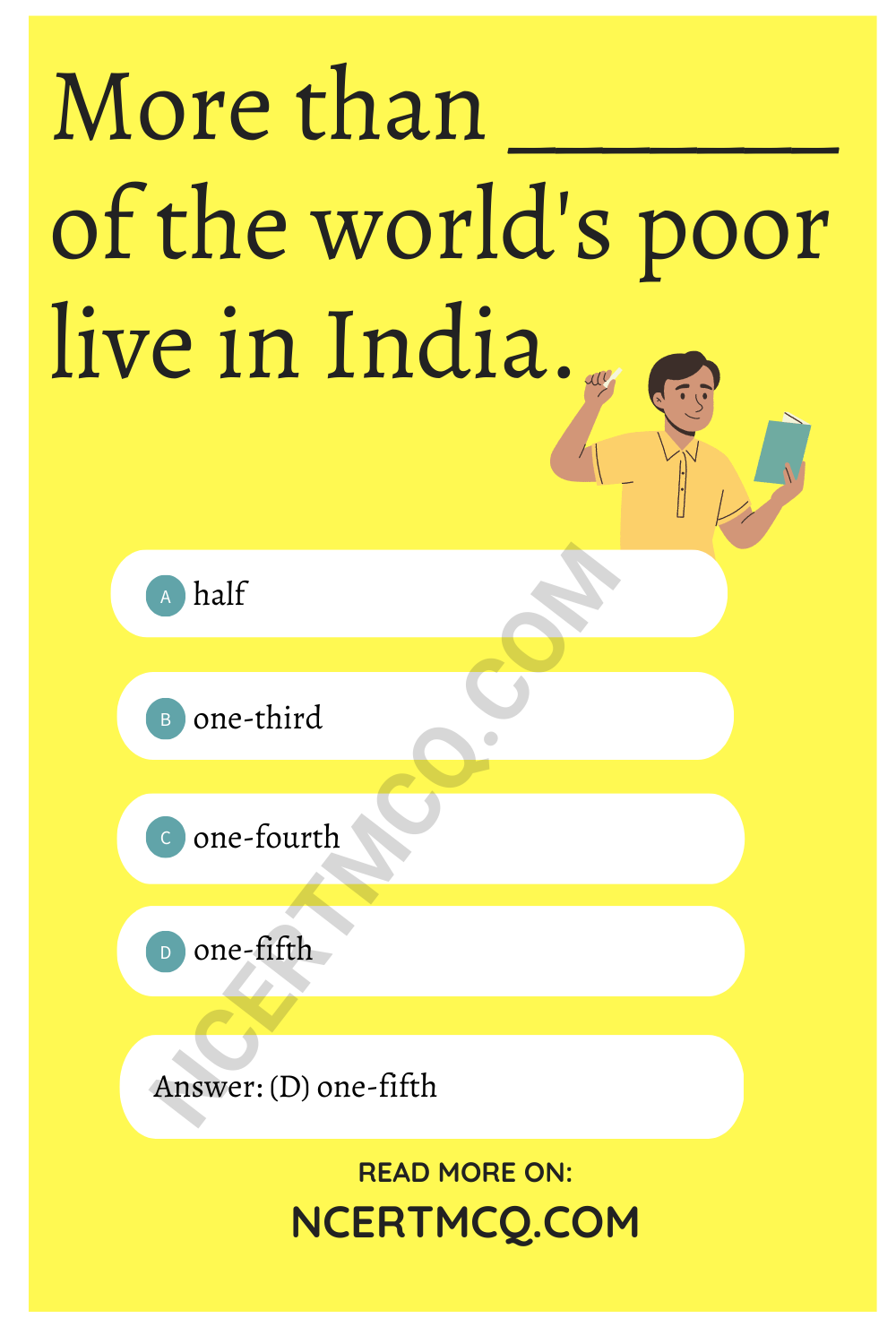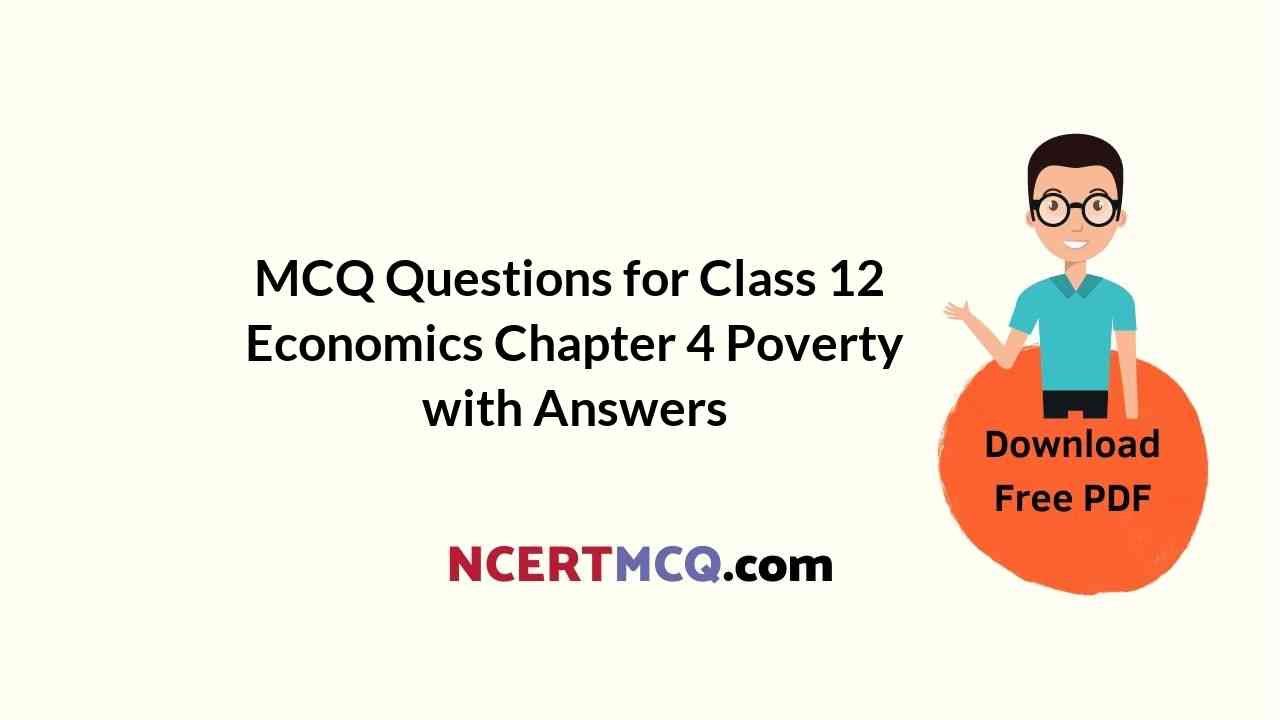Check the below NCERT MCQ Questions for Class 12 Economics Chapter 4 Poverty with Answers Pdf free download. MCQ Questions for Class 12 Economics with Answers were prepared based on the latest exam pattern. We have provided Poverty Class 12 Economics MCQs Questions with Answers to help students understand the concept very well.
Class 12 Economics Chapter 4 Poverty MCQ With Answers
Economics Class 12 Chapter 4 MCQs On Poverty
I. Choose the correct alternative.
Poverty MCQ Class 12 Chapter 4 Question 1.
More than _______ of the world’s poor live in India.
(A) half
(B) one-third
(C) one-fourth
(D) one-fifth
Answer
Answer: (D) one-fifth

Poverty Class 12 MCQ Chapter 4 Question 2.
What was the percentage of the population below the poverty line in India in 2011-12?
(A) 26.1%
(B) 19.3%
(C) 22%
(D) 32%
Answer
Answer: (C) 22%
MCQ Of Poverty Class 12 Chapter 4 Question 3.
Which of the following is the poverty determination measure?
(A) Head Count Ratio
(B) Sen Index
(C) Poverty Gap Index
(D) All of these
Answer
Answer: (D) All of these
MCQ On Poverty Class 12 Chapter 4 Question 4.
When was the Task Force on Projections of Minimum Needs and Effective Consumption Demand was formed?
(A) 1969
(B) 1979
(C) 1989
(D) 1999
Answer
Answer: (B) 1979
Class 12 Poverty MCQ Chapter 4 Question 5.
Those who regularly move in and out of poverty are called
(A) Chronically poor
(B) Churning poor
(C) Occasionally poor
(D) Transient poor
Answer
Answer: (B) Churning poor
Poverty Chapter Class 12 MCQ Chapter 4 Question 6.
In 2011-12, poverty line was defined worth ________ as consumption per person a month for rural areas and _______ for urban areas.
(A) ₹816 and ₹1,000
(B) ₹1,012 and ₹1,210
(C) ₹550 and ₹860
(D) ₹860 and ₹673
Answer
Answer: (A) ₹816 and ₹1,000
MCQs Of Poverty Class 12 Chapter 4 Question 7.
Which of the following is an action adopted under the provision of minimum basic amenities to the people?
(A) Prime Minister’s RozgarYojna
(B) Swarna Jayanti Shahari RozgarYojna
(C) Pradhan Mantri Gramodaya Yojna
(D) National Rural Livelihood Mission
Answer
Answer: (C) Pradhan Mantri Gramodaya Yojna
Poverty Class 12 MCQ Questions Chapter 4 Question 8.
In 2011-12, which state had the highest poverty rate in India?
(A) Odisha
(B) Bihar
(C) Madhya Pradesh
(D) West Bengal
Answer
Answer: (A) Odisha
MCQ Poverty Class 12 Chapter 4 Question 9.
NFWP was launched in:
(A) November 2004
(B) December 2003
(C) November 2002
(D) December 2005
Answer
Answer: (A) November 2004
Poverty Chapter MCQ Chapter 4 Question 10.
Which of the following programmes provide assistance to elderly people are given under?
(A) VAMBAY
(B) NSAP
(C) PMGY
(D) PMRY
Answer
Answer: (B) NSAP

II. Fill in the blanks with the correct answer.
MCQ Of Chapter Poverty Class 12th Chapter 4 Question 1.
Poverty is the inability to secure the ________ consumption requirements for life, health, and efficiency.
Answer
Answer: minimum
Question 2.
Absolute poverty determines the minimum physical quantities of the requirement for a subsistence level, with the help of ______
Answer
Answer: poverty line
Question 3.
______ and hunger are the key features of the poorest households.
Answer
Answer: Starvation
Question 4.
Task Force on Projections of Minimum Needs and Effective Consumption Demand’ was formed in _________
Answer
Answer: 1979
Question 5.
______ includes those who are usually poor but who may sometimes have relatively more money.
Answer
Answer: Chronic poor
Question 6.
_________ is the proportion of persons living below the poverty line.
Answer
Answer: HeadCount Ratio
Question 7.
Amartya Sen, noted Nobel Laureate, has developed an index known as _________
Answer
Answer: Sen Index
Question 8.
The proportion of poor to the population in India was ______ percent in 2011-12.
Answer
Answer: 22
Question 9.
Under the British, India began to export food grains and, as a result, as many as ________ people died in famines between 1875 and 1900.
Answer
Answer: 26 million
Question 10.
There exists a direct relationship between _________ and poverty.
Answer
Answer: Unemployment
III. State whether the following statements are true or false.
Question 1.
More than one-fifth of the worlds poor live in India.
Answer
Answer: True
Question 2.
Absolute poverty refers to a lack of resources in relation to different classes, regions, and countries.
Answer
Answer: False
Question 3.
Transient poor covers those people who are rich most of the time but may sometimes suffer bad luck are said to be occasionally poor.
Answer
Answer: False
Question 4.
The minimum calorie intake was estimated at 2,400 calories for a rural person and 2,100 for a person in the urban area.
Answer
Answer: True
Question 5.
Uttar Pradesh, Bihar, Madhya Pradesh, West Bengal, and Orissa account for about 70 percent of India’s poor.
Answer
Answer: True
Question 6.
Britain’s main goals from the Raj were to provide a market for British exports.
Answer
Answer: True
Question 7.
The poverty ratio estimates the minimum level of income that is considered appropriate to secure basic necessities of life.
Answer
Answer: False
Question 8.
The government of India adopted a five-dimensional approach as an attempt to reduce poverty.
Answer
Answer: True
Question 9.
National Food for Work Programme aims at improving the food and nutritional status of the poor.
Answer
Answer: False
Question 10.
Due to unequal distribution of land and other assets, mostly non-poor appropriate the benefits from direct poverty alleviation programmes.
Answer
Answer: True
IV. Match the following.
Question 1.
| Column-I | Column-II |
| 1. Poverty | (A) Proportion of persons living below the poverty line |
| 2. Poverty line | (B) Poverty is measured in monetary terms |
| 3. Absolute poverty | (C) Poverty is measured with respect to various classes |
| 4. Relative poverty | (D) Inability to secure the basic needs |
| 5. Headcount ratio | (E) 1999 |
| 6. Food for Work Programme | (F) Divides people into poor and non-poor |
| 7. Swaran Jayanti Gram Swarozgar Yojana | (G) 1970 |
| 8. Sampoorna Grameen Rozgar Yojana | (H) 2001 |
| 9. NFW programme | (I) Never poor |
| 10. Non-poor | (J) 2004 |
Answer
Answer:
| Column-I | Column-II |
| 1. Poverty | (D) Inability to secure the basic needs |
| 2. Poverty line | (F) Divides people into poor and non-poor |
| 3. Absolute poverty | (B) Poverty is measured in monetary terms |
| 4. Relative poverty | (C) Poverty is measured with respect to various classes |
| 5. Headcount ratio | (A) Proportion of persons living below the poverty line |
| 6. Food for Work Programme | (G) 1970 |
| 7. Swaran Jayanti Gram Swarozgar Yojana | (E) 1999 |
| 8. Sampoorna Grameen Rozgar Yojana | (H) 2001 |
| 9. NFW programme | (J) 2004 |
| 10. Non-poor | (I) Never poor |
We hope the given NCERT MCQ Questions for Class 12 Economics Chapter 4 Poverty with Answers Pdf free download will help you. If you have any queries regarding CBSE Class 12 Economics Poverty MCQs Multiple Choice Questions with Answers, drop a comment below and we will get back to you soon.
Class 12 Economics Indian Economic Development with Answers MCQ:
- Indian Economy on the Eve of Independence Class 12 MCQ
- Indian Economy 1950-1990 Class 12 MCQ Questions
- Liberalisation, Privatisation and Globalisation: An Appraisal Class 12 MCQ
- Poverty Class 12 MCQ
- Human Capital Formation in India Class 12 MCQ
- Rural Development Class 12 MCQ
- Employment: Growth, Informalisation and Other Issues Class 12 MCQ
- Infrastructure Class 12 MCQ
- Environment and Sustainable Development Class 12 MCQ
- Comparative Development Experiences of India and its Neighbours Class 12 MCQ
